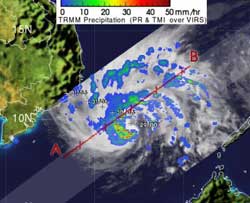NASA's TRMM satellite sees newborn Tropical Storm Pakhar's heavy rain

NASA's TRMM satellite measured rainfall rates in Tropical Storm Pakhar on March 29 at 1123 UTC (7:23 a.m. EDT).Light to moderate rainfall is depicted in blue and green, falling at a rate between .78 to 1.57 inches (20 to 40 mm) per hour. Heavy rainfall is seen in red, and is falling at 2 inches/50 mm per hour. Credit: SSAI/NASA, Hal Pierce<br>
NASA's Tropical Rainfall Measuring Mission (TRMM) satellite passed over Pakhar on March 29, and saw that it was generating mostly light to moderate rainfall around the entire system, with areas of heavy rain in the southwestern and northeastern quadrants.
Light to moderate rainfall rates were between .78 to 1.57 inches (20 to 40 mm) per hour and heavy rain was falling at a rate of 2 inches/50 mm per hour. The banding of thunderstorms has continued to consolidate and strengthen since March 28, which accounts for the cyclone's increase in strength.
On March 29 at 1500 UTC (11 a.m. EDT) Pakhar's maximum sustained winds virtually exploded from 35 knots (40.2 mph/64.8 kph) to 60 knots (69 mph/111 kph) within 12 hours because it is in an environment with lower wind shear and warm sea surface temperatures.
Pakhar is centered near 10.0 North and 111.6 East, about 300 nautical miles east of Ho Chi Minh City, Vietnam. It is moving to the west-northwest near 3 knots (3.4 mph/5.5 kph).
Forecasters at the Joint Typhoon Warning Center expect Pakhar to make landfall in central Vietnam, north of Ho Chi Minh City on March 31. Residents should prepare for rough surf along beaches, gusty winds and heavy rainfall.
Media Contact
More Information:
http://www.nasa.govAll latest news from the category: Earth Sciences
Earth Sciences (also referred to as Geosciences), which deals with basic issues surrounding our planet, plays a vital role in the area of energy and raw materials supply.
Earth Sciences comprises subjects such as geology, geography, geological informatics, paleontology, mineralogy, petrography, crystallography, geophysics, geodesy, glaciology, cartography, photogrammetry, meteorology and seismology, early-warning systems, earthquake research and polar research.
Newest articles

Superradiant atoms could push the boundaries of how precisely time can be measured
Superradiant atoms can help us measure time more precisely than ever. In a new study, researchers from the University of Copenhagen present a new method for measuring the time interval,…

Ion thermoelectric conversion devices for near room temperature
The electrode sheet of the thermoelectric device consists of ionic hydrogel, which is sandwiched between the electrodes to form, and the Prussian blue on the electrode undergoes a redox reaction…

Zap Energy achieves 37-million-degree temperatures in a compact device
New publication reports record electron temperatures for a small-scale, sheared-flow-stabilized Z-pinch fusion device. In the nine decades since humans first produced fusion reactions, only a few fusion technologies have demonstrated…





















